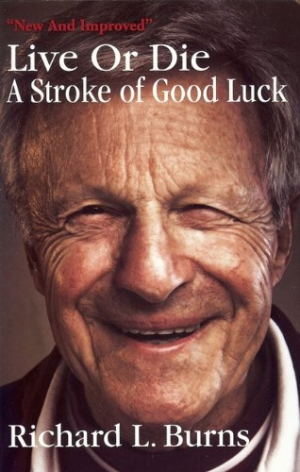
Live or Die
A Stroke of Good Luck
“I died and came back to life. So what I have to say is special,” explains Richard L. Burns in his inspirational first-person account, Live or Die: A Stroke of Good Luck. Only 38 when felled by a hemorrhagic stroke in 1968, Burns was not expected to pull through, let alone go on to live a productive, fulfilling life. The obituary his wife Nancy was advised to write for him at the time remains a constant reminder of his survival against the odds.
Although Burns survived, his massive stroke served as the end of the life he had been living. A high-powered advertising executive, he had thought he was living the dream. “Ego had taken charge,” he now admits. When his world came crashing down, he needed to readjust and find meaning elsewhere. He spent years working through both the physical ordeal and the mental anguish. Even with job loss and financial hardship compounding already difficult circumstances, he not only survived but also found happiness and a new sense of purpose. In Live or Die, Burns recounts his painfully slow, self-directed recovery, revealing his best and worst moments along the way, and offers hope and advice to fellow victims of life-altering injuries and illnesses.
Burns’s book is filled with anecdotes and spiritual, although not particularly religious, advice. He writes as a friend might talk, sometimes joking, occasionally serious, always upbeat, and never dismissive. His words are heartfelt. He tells on himself often, displaying humor in hindsight as he divulges his reactions to issues that thwarted him in his recovery. Able to laugh at the absurdity of it all yet take pride in what he has accomplished, Burns displays a charming wit as he offers his insider’s view and shares helpful advice based on his most trying experiences.
“Sure, I lamented what was lost but I was beginning to appreciate and look for that something that was better than what was,” he writes, and this attitude is present throughout Live or Die. Burns never says that the path to recovery from a debilitating event is an easy one, but his upbeat tone is so engaging that virtually anything seems possible. He provides his own guide to the stages of recovery, including “the ‘dead’ man’s Eight Steps to Recovery and Renovation.” Those steps and the other practical information he includes represent much of what the author learned by trial and error during his recuperation, and it is carefully organized to be helpful to others facing similar ordeals.
Live or Die is not great literature, but it is inspiring. “You can do as well [as I did] and probably better,” he states. Adding levity to a deadly serious matter, he is encouraging and sometimes very funny. Naming each chapter for a different advertising slogan—for example, “It Takes a Licking and Keeps on Ticking” and “Just Do It!”—Burns elicits many a knowing smile. But he also condenses his message to its essence. “Hope and optimism worked wonders” during his recovery, he asserts, and they are exactly what he offers so engagingly through his life story.
Reviewed by
Cheryl Hibbard
Disclosure: This article is not an endorsement, but a review. The publisher of this book provided free copies of the book and paid a small fee to have their book reviewed by a professional reviewer. Foreword Reviews and Clarion Reviews make no guarantee that the publisher will receive a positive review. Foreword Magazine, Inc. is disclosing this in accordance with the Federal Trade Commission’s 16 CFR, Part 255.
